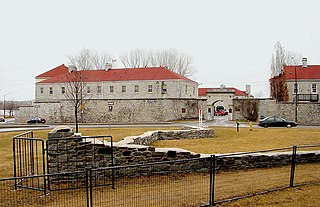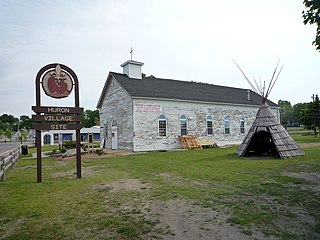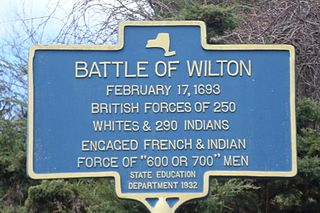Related Research Articles

New France was the territory colonized by France in North America, beginning with the exploration of the Gulf of Saint Lawrence by Jacques Cartier in 1534 and ending with the cession of New France to Great Britain and Spain in 1763 under the Treaty of Paris.

King William's War was the North American theater of the Nine Years' War (1688–1697), also known as the War of the Grand Alliance or the War of the League of Augsburg. It was the first of six colonial wars fought between New France and New England along with their respective Native allies before France ceded its remaining mainland territories in North America east of the Mississippi River in 1763.

Louis de Buade, Comte de Frontenac et de Palluau was a French soldier, courtier, and Governor General of New France in North America from 1672 to 1682, and again from 1689 to his death in 1698. He established a number of forts on the Great Lakes and engaged in a series of battles against the English and the Iroquois.
The Beaver Wars, also known as the Iroquois Wars or the French and Iroquois Wars were a series of conflicts fought intermittently during the 17th century in North America throughout the Saint Lawrence River valley in Canada and the Great Lakes region which pitted the Iroquois against the Hurons, northern Algonquians and their French allies. As a result of this conflict, the Iroquois destroyed several confederacies and tribes through warfare: the Hurons or Wendat, Erie, Neutral, Wenro, Petun, Susquehannock, Mohican and northern Algonquins whom they defeated and dispersed, some fleeing to neighboring peoples and others assimilated, routed, or killed.

This section of the Timeline of Quebec history concerns the events relating to the Quebec portion of New France between the establishment of the Sovereign Council and the fall of Quebec.

The Great Peace of Montreal was a peace treaty between New France and 39 First Nations of North America that ended the Beaver Wars. It was signed on August 4, 1701, by Louis-Hector de Callière, governor of New France, and 1300 representatives of 39 Indigenous nations.

Fort Frontenac was a French trading post and military fort built in July 1673 at the mouth of the Cataraqui River where the St. Lawrence River leaves Lake Ontario, in a location traditionally known as Cataraqui. It is the present-day location of Kingston, Ontario, Canada. The original fort, a crude, wooden palisade structure, was called Fort Cataraqui but was later named for Louis de Buade de Frontenac, Governor of New France who was responsible for building the fort. It was abandoned and razed in 1689, then rebuilt in 1695.

Joseph-Antoine le Fèbvre, sieur de La Barre was a French lawyer and administrator best known for his disastrous three years as governor of the colony of New France (Quebec).

Jacques-René de Brisay de Denonville, Marquis de Denonville was Governor General of New France from 1685 to 1689 and was a key figure in the Beaver Wars.
Pierre Millet (Milet) was a French Jesuit missionary to the Iroquois people in the area that is now New York State.

Ganondagan State Historic Site, also known as Boughton Hill, is a Native American historic site in Ontario County, New York in the United States. Location of the largest Seneca village of the 17th century, the site is in the present-day Town of Victor, southwest of the Village of Victor. The village was also referred to in various spellings as Gannagaro, Canagora, Gandagora, Gandagaro and Gannontaa.

Fort de Buade was a French fort in the present U.S. state of Michigan's Upper Peninsula across the Straits of Mackinac from the northern tip of lower Michigan's "mitten". It was garrisoned between 1683 and 1701. The city of St. Ignace developed at the site, which also had the historic St. Ignace Mission founded by Jesuits. The fort was named after New France's governor at the time, Louis de Buade de Frontenac.
Jean de Lamberville was a Jesuit priest who arrived in New France from France in 1669. He was the older brother of Jacques de Lamberville. Jean became a missionary to the Onondagas and had success in converting their chief, Garakontie. He also was well known for his knowledge in the medical treatments of his time.
The Compagnie du Nord was a French colonial fur-trading company, founded in Québec City 1682 by a group of Canadien financiers with the express intent of competing with the English Hudson's Bay Company. It was founded by Charles Aubert de La Chesnaye with the assistance of Pierre-Esprit Radisson and his brother-in-law Médard Chouart des Groseilliers.
Louis-Henri de Baugy, Chevalier de Baugy was from a noble family of France and came to New France as a member of the party of Joseph-Antoine de La Barre, who was replacing Buade de Frontenac as Governor General.

The Lachine massacre, part of the Beaver Wars, occurred when 1,500 Mohawk warriors launched a surprise attack against the small settlement of Lachine, New France, at the upper end of Montreal Island, on the morning of 5 August 1689.

The Iroquois, also known as the Five Nations or the Six Nations and by the autonym Haudenosaunee, are an Iroquoian-speaking confederacy of Native Americans and First Nations peoples in northeast North America and Upstate New York. They were known during the colonial years to the French as the "Iroquois League", and later as the "Iroquois Confederacy". The English called them the "Five Nations", including the Mohawk, Oneida, Onondaga, Cayuga, and Seneca. After 1722, the Iroquoian-speaking Tuscarora from the southeast were accepted into the confederacy, which became known as the Six Nations.

Kondiaronk, known as Le Rat, was Chief of the Native American Wendat people at Michilimackinac in New France. As a result of an Iroquois attack and dispersal of the Hurons in 1649, the latter settled in Michilimackinac. The Michilimackinac area refers to the strait between Lakes Huron and Michigan in the present day United States.
Louis de La Porte de Louvigny was a military officer in France and Canada, who fought during the French and Indian wars.

The Battle of Wilton was a battle fought in 1693 in Wilton, New York between Colonial Militia and allied Native forces on one hand and French forces and their Native allies as part of King William's War.
References
- 1 2 3 4 Butrleigh, H.C. "Ouarhouare". Dictionary of Canadian Biography. University of Toronto. Archived from the original on 2013-12-24. Retrieved 16 October 2015.
- ↑ Gilles Havard (2001). Great Peace of Montreal of 1701: French-Native Diplomacy in the Seventeenth Century . McGill-Queen's Press. p. 55. ISBN 9780773569348 . Retrieved 2017-10-26.
Ourehouare cayuga.
- Encyclopedia of the Haudenosaunee (Iroquois Confederacy)
- "Orehaoue". L’Encyclopédie de l’histoire du Québec / The Quebec History Encyclopedia. Marianapois College. Retrieved 16 October 2015.